
 |
|
|
#1 |
|
All the news that's fit to excerpt
Name: newsie
Location: who knows?
Join Date: Jun 2008 Motorcycle(s): only digital replicas Posts: Too much.
|
[motorcycle.com] - Middleweight Sport-Touring Shootout – Caponord Vs Multistrada Vs N
 According to my weather app, it was officially 100 degrees at 10pm the night we rode in to Borrego Springs, CA, during our Middleweight Sport-Touring Shootout. I’m sitting poolside sipping a tasty, cold beverage while bossmen, Kevin Duke and Sean Alexander, discuss the finer points of gun control in the parking lot. Get the Flash Player to see this player. Thankfully, we’re not aboard those overweight rigs from our recent Heavyweight Sport-Touring Shootout; the wind protection from those two-wheel barn doors would have had us dead from heat exhaustion before reaching the bottom of Montezuma Grade. These three lighter, sportier, sport-tourers are much better suited to aggressive riding in hot climes. And although two bikes in this test are quasi sport-adventure-tourers, they’re still a heap load more fun in the tight stuff. Well, at least two of the three are. Aprilia’s recently launched Caponord and its bevy of electronic aids have garnered much attention – some good, some not so good. MO’s, Troy Siahaan wrote a very complimentary review of the Caponord following the bike’s press launch a few months ago. But now, in the harsh reality of judgement among its peers, the Caponord’s weak points become more apparent. 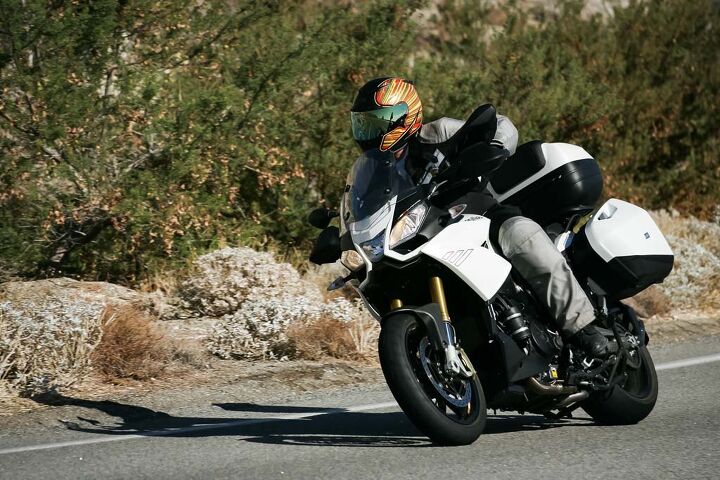 In the context of this group, the Capo is the comfy, more touringish bike, similar to how we rated the Triumph Trophy in our Heavyweight Sport-Touring Shootout. In the context of this group, the Capo is the comfy, more touringish bike, similar to how we rated the Triumph Trophy in our Heavyweight Sport-Touring Shootout.Aprilia Dynamic Damping, an unwisely chosen acronym of ADD – as in attention deficit disorder, by which we mean to say: “Hey, Aprilia suspension, quit yer daydreaming, I’m going fast now, would you please stiffen up.” But it pays no heed when ridden aggressively on bumpy roads, marshmallowing along, occasionally bottoming out and performing with a general sense of wallow. “When ridden quickly in the twisties, the Aprilia starts sending nauseating warning messages early and often,” says Alexander. A statement to which Duke agrees, saying, “It feels less buttoned-down while cornering in the full-auto ADD mode than I’d like. In terms of front-end feedback and rider confidence at a fast pace, the uncertain-feeling Capo rates a distant third.” 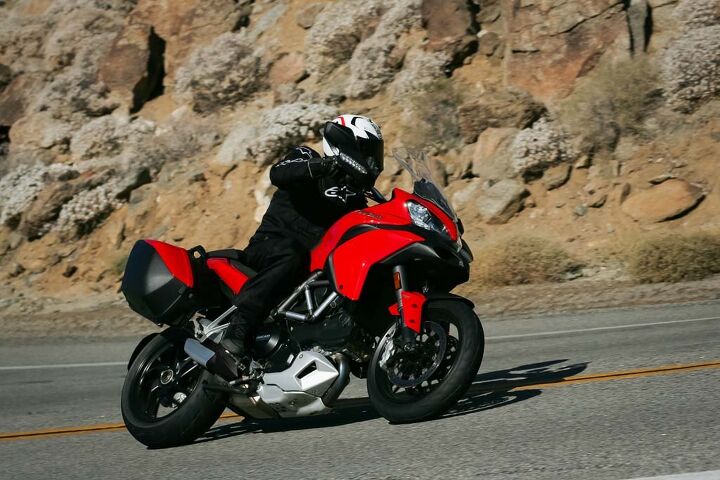 The Ducati Twin throbs at 80 mph/4,500 rpm in top-gear. Its handling demands you keep pressure on the inside bar through sweeping corners. Short legs beware, the Multi’s seat is claimed to be 33.5 inches from the ground and feels even taller. The Ducati Twin throbs at 80 mph/4,500 rpm in top-gear. Its handling demands you keep pressure on the inside bar through sweeping corners. Short legs beware, the Multi’s seat is claimed to be 33.5 inches from the ground and feels even taller.In completely opposite land resides Ducati’s Skyhook suspension. The Touring S manages composure whether you’re riding slow and vertical or fast and leaned – automatically tightening and loosening damping settings depending on conditions and riding modes. “The Multi’s stiffness and rigidity stands in sharp contrast to the Caponord’s plushness, whether referring to the suspension, chassis, seat or the way it makes your private parts feel,” quips Duke. One of the biggest differences between the Ducati’s semi-active Skyhook suspension and the Caponord’s active/semi-active ADD is the Aprilia’s ability to automatically adjust the preload of its shock. There exists numerous other ways in which the two systems differ, and the ADD may be more advanced in its functionality compared to Ducati’s Skyhook, but whether due to overly soft springs, incorrect damping settings or a combination thereof, we believe Aprilia needs to better refine its ADD system. “I had a scare while running deep into a bumpy, downhill corner with ADD set in its full-auto mode,” says Duke. “The system seemed to dial up an excess of front compression damping in an attempt to keep the chassis level, causing a front-end chatter that unexpectedly released grip from the front tire.” 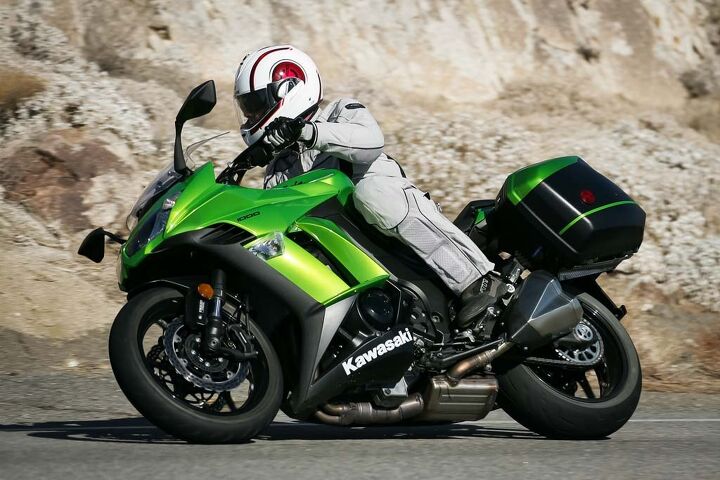 How did the Kawi get into a brawl with two sport-adventure-tourers? Our shootout requirements demanded hard luggage and chain drive. Honda’s new Interceptor was meant to be included to help balance the equation of traditional sport-touring vs sport-adventure-touring, but an example with bags was unavailable at the time of testing. How did the Kawi get into a brawl with two sport-adventure-tourers? Our shootout requirements demanded hard luggage and chain drive. Honda’s new Interceptor was meant to be included to help balance the equation of traditional sport-touring vs sport-adventure-touring, but an example with bags was unavailable at the time of testing.Then there’s Kawasaki’s Ninja 1000 and its manually adjustable suspension (lacking only rear compression-damping adjustment), which seems passe next to the active Italian dampers. However, it works better and with more consistency than the Caponord’s fancy-schmancy ADD. No complaints were logged regarding the Ninja’s suspenders, and it came in a comfortable second in the suspension category of the ScoreCard, which also contributed to the Ninja winning the handling category of the ScoreCard despite feeling a little less nimble than the Italian duo. “While the Ninja shares a 190mm rear tire width with the Multistrada, the Kawi uses the now-antiquated 50-series profile instead of the Duc’s modern 190/55 size,” says Duke. “This contributes greatly to the Kawi’s relatively sluggish steering response. And yet the Ninja does a nice job at unwinding a twisty road, aided by a wheelbase (56.9 inches) at least three inches shorter than the rangy Italians.” Even without the massive amounts of leverage provided by the two sport-adventure-tourer’s wide handlebars, a rider can choose exactly where he wants to put the Kawi at any given time, in any given corner. The Ninja remains stable in long sweepers and outperforms its taller, adventurish rivals in higher-speed environments. The Kawi’s engine is also worthy of mention as it handily out-gunned both the Duc and Capo in top-gear roll-ons, even though its down a few hp and ft-lbs to the Multistrada. 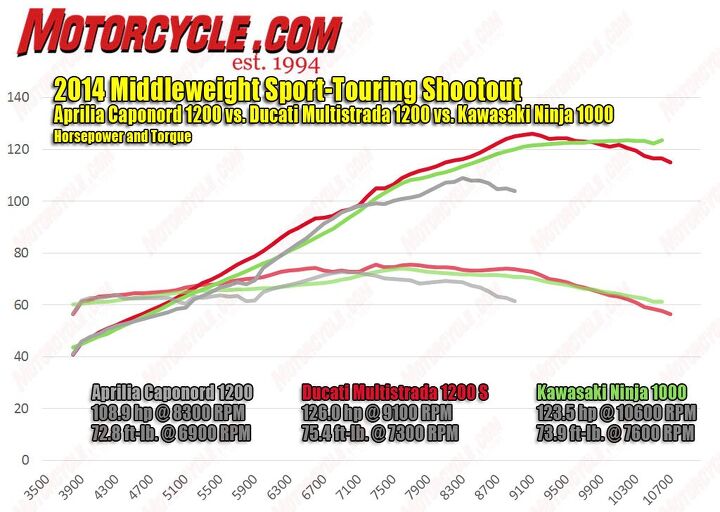 The Capo’s dyno chart draws the ugliest lines of the three, exhibiting peaks and valleys that illustrate its poor fueling and tendency to surge under neutral throttle. Check out the Kawi’s torque curve; It’s not often you see a 1000cc inline-Four with more torque than a 1200cc Twin. The Capo’s dyno chart draws the ugliest lines of the three, exhibiting peaks and valleys that illustrate its poor fueling and tendency to surge under neutral throttle. Check out the Kawi’s torque curve; It’s not often you see a 1000cc inline-Four with more torque than a 1200cc Twin.“Even though it isn’t as torquey as the Multistrada, the Ninja 1000 easily and decisively walks-away from both the Aprilia and Ducati in any contest of acceleration,” says Alexander. Considering*the two Italians share engine architecture, the Twin in each exhibits astoundingly different characteristics. Where the Testastretta 11° L-Twin launches from a standing start with gobs of low-end grunt, the majority of the Aprilia’s power resides high in the rev range of its 90-degree Twin. The Capo also suffers from a surprisingly glitchy EFI and R-b-W. 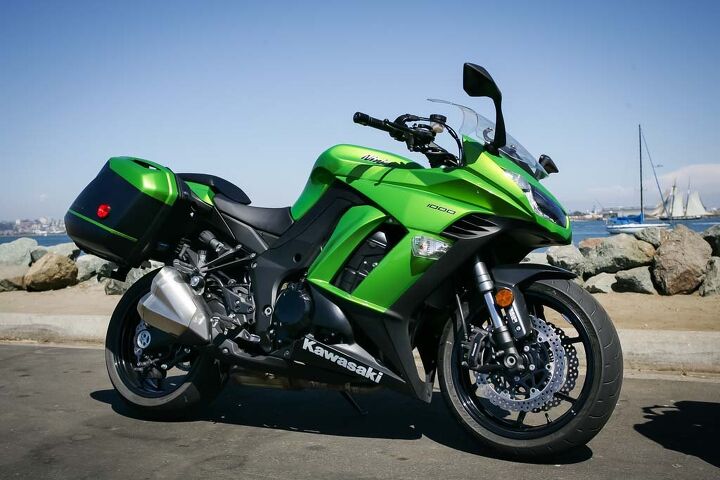 + Highs</p>
But, for those less inclined to ride at higher speeds and steeper lean angles, the softer Caponord could be the better choice as the only model here with cruise control (albeit a rudimentary system) and the greatest amount of wind protection. The Aprilia was also best outfitted for the passenger accommodations. “The passenger seat is narrower than the Duc’s, but reasonably thick padding is accommodating to a posterior,” says Duke. “A raised forward end of the saddle inhibits sliding forward during braking. The top case includes a backrest pad, which greatly adds to a feeling of security for passengers.” 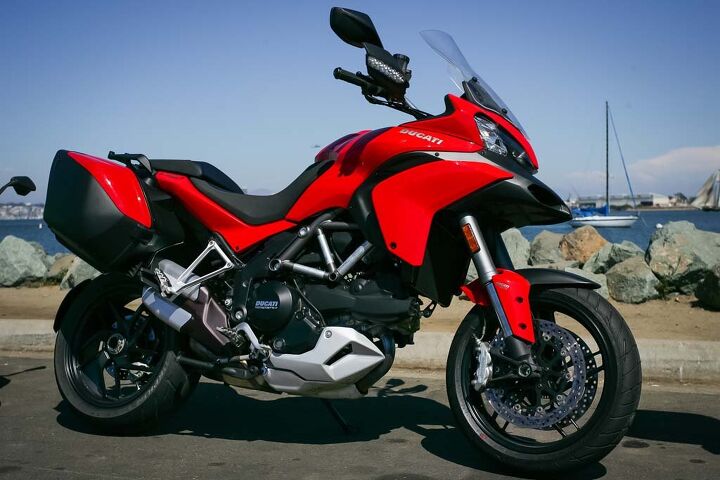 + Highs</p>
At 32.3 inches the Ninja has the lowest seat height by nearly an inch compared to the Capo and more than an inch on the Ducati. It’s narrow passenger seat, however, offers the least amount of pillion comfort of the three. 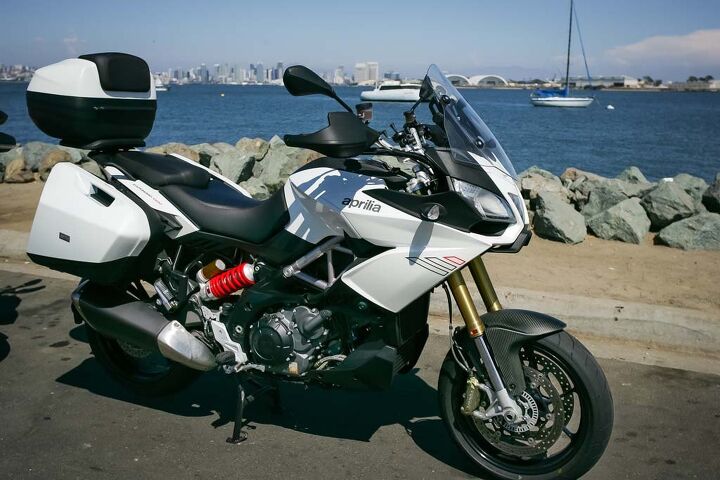 + Highs</p>
As noted in our initial review of the Ninja 1000, the bike’s hard saddlebag kit lists for $1,269.75. There’s also a choice of a 39-liter top case ($139.95), but due to different mounting hardware, the saddlebags and top case cannot be attached simultaneously. If more carrying capacity is needed, there’s a wide selection of soft luggage available from Kawasaki specifically designed for the Ninja 1000. 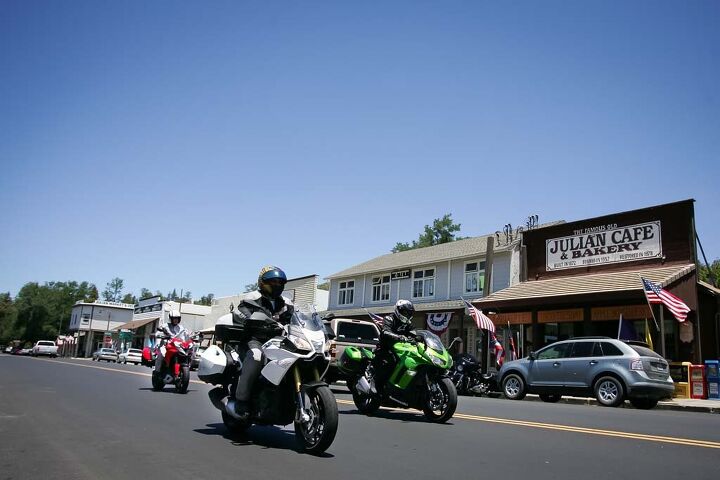 Egad! At 599 pounds wet, the Caponord is almost deserving of a place in our Heavyweight Sport-Touring Shootout. The Aprilia is, in fact, closer to the weight of the Yamaha FJR1300ES (644 lbs) than it is to the Multistrada’s 543 lbs. Its heated grips are a $200 option, the Duc’s are included in the price. Egad! At 599 pounds wet, the Caponord is almost deserving of a place in our Heavyweight Sport-Touring Shootout. The Aprilia is, in fact, closer to the weight of the Yamaha FJR1300ES (644 lbs) than it is to the Multistrada’s 543 lbs. Its heated grips are a $200 option, the Duc’s are included in the price.In the end, it turned out that all the technology couldn’t keep the Duc or the Capo in front of the Kawasaki on the ScoreCard. Factoring in the objective scores of price and weight, the more analog bike has enough of an advantage to claim victory over the pricey Multistrada, the bike that each editor scored as the subjective winner. The Caponord, while a fantastic bargain considering its arsenal of electronics and the only bike here with cruise control, couldn’t overcome the shortcomings of its ADD suspension system, unrefined EFI and R-b-W, and it’s quirky handling manners. You have the option of choosing the non-ADD mode such as solo rider, solo rider with luggage, two-up and two-up with luggage, and Aprilia says that for fast canyon riding the stiffest setting (two-up with luggage) is the preferred choice. However, we tried that and didn’t notice a significant improvement in suspension performance. 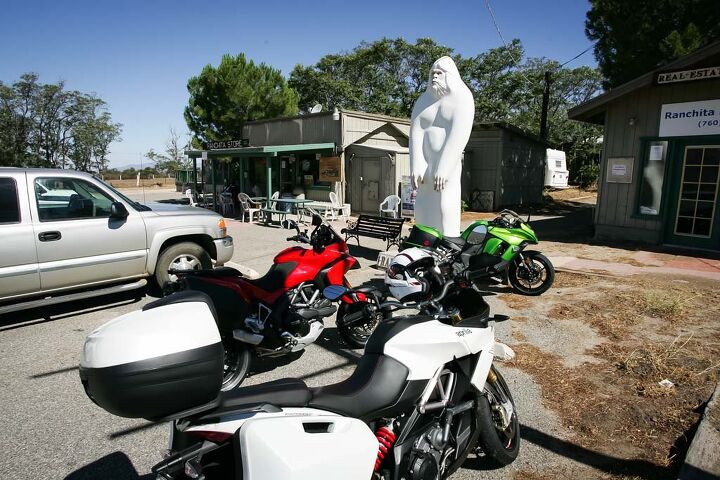 The desert yeti on sentry duty. The Kawi’s 1,053cc inline-Four feels like a large electric motor and pulls hard just about everywhere on the tach, especially in the midrange. At 80 mph, the Duc’s engine is spinning at 4500 rpm, 1000 revs lower than the Ninja. When powered on, the Capo’s cruise control indicator lamp flashes green which is annoying and easily confused with the turn-signal indicator. When activated it turns solid green. The desert yeti on sentry duty. The Kawi’s 1,053cc inline-Four feels like a large electric motor and pulls hard just about everywhere on the tach, especially in the midrange. At 80 mph, the Duc’s engine is spinning at 4500 rpm, 1000 revs lower than the Ninja. When powered on, the Capo’s cruise control indicator lamp flashes green which is annoying and easily confused with the turn-signal indicator. When activated it turns solid green.“What a shame,” says Alexander. “That squishy electronic suspension costs significant dough, raising the Caponord’s base MSRP. If our test bike*was available*with old-school twisty-knob adjusters, it would quite likely*make*a fantastic sport-touring motorcycle and might have been priced near to the*saddlebag-equipped Ninja.” The Ninja isn’t perfect, exhibiting a high-frequency buzz*in the upper rev-range*in various gears (thankfully not at freeway cruising speeds), but the way in which it goes about its duties without the influence of electronic suspension for a far more attainable price tag makes it the winner of*this shootout. 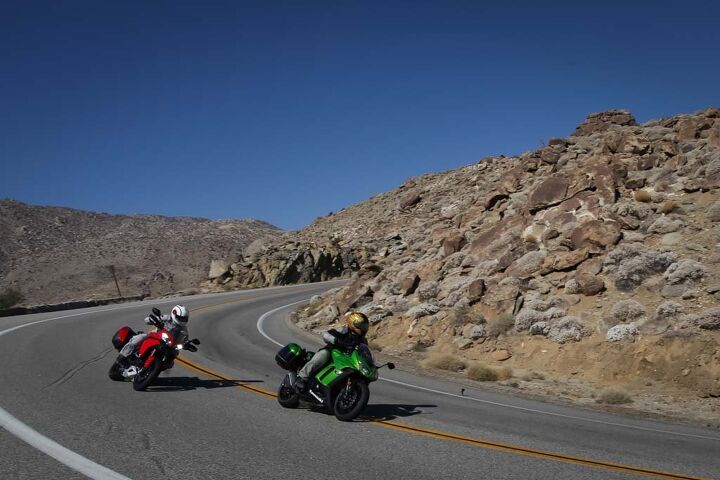 It was a close finish: 86.04% Kawi vs 85.37% Duc, but, simply put, the Multi didn’t perform $5,500 better than the Ninja. It was a close finish: 86.04% Kawi vs 85.37% Duc, but, simply put, the Multi didn’t perform $5,500 better than the Ninja.Alexander relates; “At the end of our first day’s ride it was time for one last rotation before making the final slog to our arid desert hotel. I thought it was my turn on the Kawasaki and I began to quietly fret… until I realized it was actually my turn on the Aprilia. Near the end of that last leg of our route we followed S-22 down almost 4,000 feet of elevation via a sublime series of high-speed sweepers before dropping us into the furnace of Borrego Springs.*In hindsight, I would have chosen the Kawasaki’s relatively cramped ergonomics in exchange for its superior ground clearance, suspension composure, and thrust during the ride down those last few miles.” 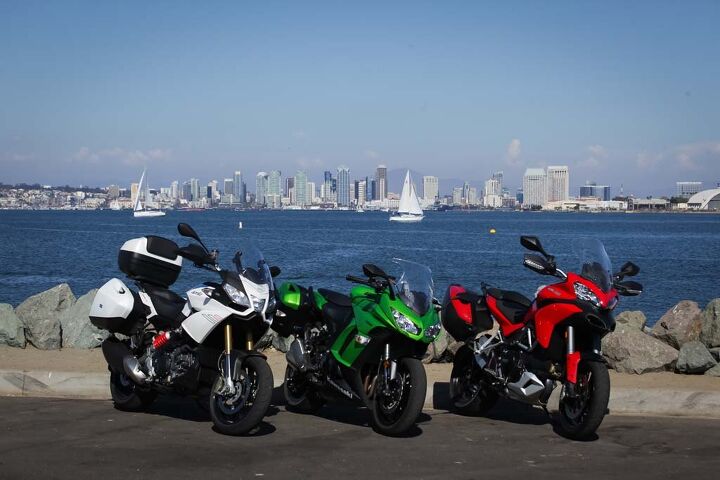 “Discovered by the Germans in 1904, they named it Saan Deeahgo, which of course, in German means a whale’s vagina.” – Ron Burgundy “Discovered by the Germans in 1904, they named it Saan Deeahgo, which of course, in German means a whale’s vagina.” – Ron Burgundy2014 Middleweight Sport-Touring Shootout ScorecardCategoryAprilia Caponord 1200 ABS Travel PackDucati Multistrada 1200 S TouringKawasaki Ninja 1000Price67.5%0.0%100.0%Weight60.0%95.0%100.0%Engine83.3%92.1%90.8%Transmission/Clutch89.2%71.7%91.7%Handling68.3%87.5%91.7%Brakes81.7%95.0%87.5%Suspension53.3% 96.7%87.5%Technologies89.2%90.0%70.0%Instruments76.7%72.5%86.7%Ergonomics/Comfort91.7%85.0%75.8%Luggage/Storage89.2%78.3%85.0%Appearance79.2%90.8%88.3%Cool Factor76.7%90.8%81.7%Grin Factor60.0%92.5%81.7%Overall Score77.9%85.4%86.0%Price and weight are scored based on objective metrics. Other scores are listed as a percentage of editors’ ratings in each category. The Engine category is double-weighted, so the Overall Score is not a total of the displayed percentages but, rather, a percentage of the weighted aggregate raw score.2014 Middleweight Sport-Touring Shootout SpecsAprilia Caponord 1200 ABS Travel PackDucati Multistrada S TouringKawasaki Ninja 1000MSRP$15,499 ($16,098.90 as tested)$19,995.00$13,268 ($14,538 as tested)Engine Capacity1197cc1198.4cc1043ccEngine TypeLiquid-cooled*60-degree*DOHC*V-Twin, four valves per cylinder,*chain driven camsLiquid-cooled*DOHC*L-Twin, four valves*per cylinder, desmodromic valve actuationLiquid-cooled*DOHC*inline-four, four valves per cylinder,*chain driven camsBore x Stroke106.0 x 67.8mm106.0 x 67.9mm77.0 x 56.0 mmCompression Ratio12.0:111.5:111.8:1Fuel SystemInjection with two injectors per cylinder and Ride by Wire throttle control with three maps: Sport (S), Touring (T), Rain (R)Electronic fuel injection, elliptical throttle bodiesDFI with four 38mm Keihin throttle bodies, oval sub-throttlesIgnitionIntegrated engine management systemDigitalTCBI with digital advanceValve TrainDOHC, 8 valvesDOHC, 8 valvesDOHC, 16 valvesTransmission6-speed, helical gears6-speed6-speedFinal DriveChainChainChainFront SuspensionFully adjustable Sachs 43 mm inverted fork. Rebound and compression electronically managed with ADD (Aprilia Dynamic Damping)48mm fully adjustable usd forks. Electronic compression & rebound damping adjustment with Ducati Skyhook Suspension41 mm inverted cartridge fork with stepless compression and rebound damping, adjustable spring preload / 4.7 in.Rear SuspensionAluminium alloy swingarm, Sachs dynamic rear monoshock absorber. Adjustable or automatic setting for spring preload coupled with electronically controlled rebound and compression damping via ADD (Aprilia Dynamic Damping)Electronic compression & rebound damping adjustment. Electronic spring pre-load adjustment with DSS Aluminium single-sided swingarm.Horizontal monoshock with stepless rebound damping, remotely adjustable spring preload / 5.4 in.Front BrakeDual 320mm discs, Brembo M432 4-piston calipers, ABSDual 320mm discs, radial-mount Brembo 4-piston calipers, ABSDual 300mm petal-type rotors with radial-mount four-piston monobloc calipers and ABSRear Brake240mm disc, Brembo 1-piston caliper, ABS245mm petal disc with ABS, 2-piston caliperSingle 250mm petal-type rotor with single-piston caliper, with ABSFront Tire120/70 ZR17120/70 ZR17120/70 ZR17Rear Tire180/55 ZR 17190/55 ZR17190/50 ZR17Seat Height33.0 in.33.5 in.32.3 in.Wheelbase61.7 in.60.2 in.56.9 in.Rake/Trail26.1º/5.0 in.25°/4.3 in.24.5 deg / 4.0 in.Curb Weight599 lb.543 lb.532 lbs.Fuel Capacity6.3 gal.5.3 gal.5.0 gal.Observed fuel mileage33.240.638.2Storage Capacity29L each58 liter28L eachAccessoriesABS, aprilia Traction Control (aTC), Aprilia Dynamic Damping (aDD), aprilia Cruise Control (aCC), central stand, painted side bags (29 + 29 lt), Full LCD instrument pannel, Adjustable windshield, Hand Guards. 40L Top Box ($399.95), Heated grips ($199.95)(Standard equipment) DSS Ducati Skyhook Suspension,DSP Ducati Safety Pack ( ABS 9ME + DTC),Riding modes, Power modes, RbW, 58 litre side luggage, heated grips and centre stand.NoneAvailable ColorsWhite, RedRedCandy Lime Green, Candy Cascade BlueWarranty24 months, unlimited mileage24 months, unlimited mileage12 monthsMiddleweight Sport-Touring Shootout – Caponord Vs Multistrada Vs Ninja appeared first on Motorcycle.com. Click here for full story...
__________________________________________________
I'm a bot. I don't need no stinkin' signature... |
|
|

|
 |
 Similar Threads
Similar Threads
|
||||
| Thread | Thread Starter | Forum | Replies | Last Post |
| [motorcycle-usa.com] - 2014 Middleweight Sport-Touring Shootout | Ninjette Newsbot | Motorcycling News | 0 | September 3rd, 2014 03:10 AM |
| [motorcycle.com] - 2014 Heavyweight Sport-Touring Shootout – K1600GT Vs. Concours14 V | Ninjette Newsbot | Motorcycling News | 0 | July 14th, 2014 05:40 PM |
| [motorcycle.com] - Our Super Middleweight Sportbike Shootout is Just Around the Corne | Ninjette Newsbot | Motorcycling News | 0 | February 6th, 2014 05:10 AM |
| [motorcycle.com] - 2013 Middleweight Sport-Touring Shootout Video | Ninjette Newsbot | Motorcycling News | 0 | July 24th, 2013 09:50 PM |
| [motorcycle-usa.com] - 2013 Middleweight Supersport Shootout X | Ninjette Newsbot | Motorcycling News | 0 | June 18th, 2013 10:10 AM |
|
|